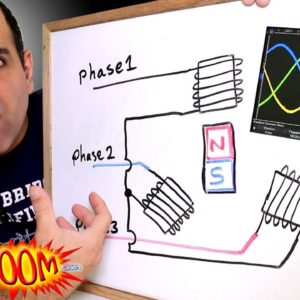Hi. In my last video, I talked about how Tesla won the AC-DC battle against Edison. But then he shoved three-phase AC down our throats instead of single-phase AC. Edison: "Oh no, he didn't. He always asked for too much" Ah, get lost Eddy! Obviously Tesla had a good reason. What is a three-phase AC? A single-phase AC is just regular sine wave, and the second phase is the same sine wave, but 120 degrees phase shifted. And the third one is also the same *sun* sine wave but another 120 degrees shifted. Each one of these signals runs on a separate wire, and the sum of these three waveforms is zero. That's all. Now, let's talk about a couple of benefits. Imagine we have a single-phase AC. How many wires do we need to run one load? Two wires to close the circuit. Now imagine we have three loads. How many wires then? We need one pair to the first load, another pair to the second load, and another pair to the third load.
So six wires in total. Now, I rearranged the supplies and loads in a Y configuration. Each one of these supplies outputs the same voltage level as the single-phase, but each one of them is a different phase in a three-phase system. I also connected all the return lines in one node going back to the source so that all the currents through the loads add up in this point, and return to their source. The voltage level across each load is the same, just 120 degrees phase shifted. And if my loads are equal, meaning their effect on current draw is the same, then at this point, I'll have the sum of three currents that are sine waves 120 degrees phase shifted, which is zero. BAM! There is no current returning to the source. Three wires eliminated.
Hallelujah. *falling board* Isn't it genius? We just added one wire compared to a single-phase AC but we are delivering three times the power to what is called the balanced load. Dab on haters.
*falling board* So, when we have a limited current capacity in a pair of wires, instead of making each one three times thicker, we just add the same thickness wire and change it into a three-phase system and deliver triple the power. Of course, this is something we do in the long distance transmission lines. In the cities, we break them into three separate phases and give one or two phases to each house. In the transmission lines, we just have to make sure that we distribute the loads for each phase equally and balanced.
But still, we sometimes run a much thinner neutral wire back to the source to take care of potential imbalance current. In Canada, we usually send two phases to each home, and we used a single 120 volt AC for most cases. But for appliances that need more power, like the oven or the laundry, we run them between two separate phases to get a higher voltage. The two phases come to some plugs like this one that we can measure. Here we have… AH F**K!! [bleep] [bleep] It is important that after you use your meter in current mode, you switch it back to voltage, otherwise, it will short your circuits. Let's try again. Here we have… around 120 volt on one outlet, and… another 120 volt on the other one, and between the two… we have zero. So it's the same phase here. In the kitchen, we have… 115 (volts) on one, and… 115 (volts) on the other one, and 203 volts between the two. So, two different phases go to each outlet. You might ask "why it is not 240 volt difference?" Because the waveforms are not 180 degrees out of phase, they are 120 degrees out of phase Okay, let's see if they look as we expect.
We just have to tie the neutral wires to the ground of the [gibberish and profanity] Hmm, I see. In DC systems, we usually show positive with red and negative or ground with black. But in Canada, in AC wiring, live is black or red or blue, depending on the phase used, and white is neutral. So, don't mix those. Okay, here's one phase…
And here's the other one. There. Two sine waves, 120 degrees out of phase. I do want to make my own three phases, but I need a three phase generator. Oh, I know. See, the other benefit of the three-phase AC system was running the three-phase AC motor, invented by Nikola Tesla himself, as well as other inventors like Galileo Ferraris, who was not as famous as Tesla. Here, I bought a bunch of brushless DC motors, the type that are used in larger drones. It is funny that they call them brushless DC, because the motor itself runs on three-phase AC, very much based on Tesla's design.
The reason they call it DC is because this motor is usually driven by DC control circuits, like this one, which is called an electronic speed controller or ESC. You provide a DC to its input and a control signal, and at the output it creates the fancy PWM, AC signal, required to drive the motor. If I turn this motor manually, it acts as a generator and makes the three-phase AC at its output. So I use one of these as the motor, tie their shaft, and turn the other one to generate the AC output. I just need a stand to mount them together, and for that, I'm gonna print a stand using my Lulzbot Mini 3D Printer, which I'll also give away one at the end of the video.

Here's the 3D model of the stand that will hold the motors face to face. And here, it's done. Oh f—-[bleep], I broke it off. Damn it. I shouldn't have grabbed it from the fragile part. There, it's done. Now, if I can only pull it up without breaking it… Heh There. Here's my stand. There. Now we just put a tape between the two shafts to hold them together, so one can turn the other.
Now I will power my driver circuit with 10 volt supply, and provide a control signal to it. In case you're wondering what the control signal is, it's a digital pulse happening every 50 to 150 milliseconds, and with a pulse width of 1 to 2 milliseconds. Adjusting the pulse widths between 1 to 2 milliseconds changes their speed from low to high. At the output of the generator, I connected 3 equal resistors in Y configuration. At the center, the voltage is the sum of the 3 AC phases, which is zero, so I can use that point as my reference and measure the AC signals. Ok, let's connect it up. Those noises are made by the driver by vibrating the motor at audible frequency, and it says it's connected. Now if we increase the pulse widths… There. We have three-phase AC signal. And if we increase the pulse widths even more…
Oh, s**t. It turns faster, and we get even higher voltage. A three-phase AC motor is a balanced load, so with only three wires, it can output three times the power compared to a single-phase AC or DC motor at the same current draw from every wire. Of course, at home we don't need that much power. So typically a single-phase AC motor like this one is enough, but in factories, for hi— Aw s**t. For high-power industrial motors in factories, three-phase is the way to go, and so, another success for Tesla's three-phase system. How does a three-phase motor work? It's typically the same as a three-phase generator.
Basically we have three sets of electromagnets placed electrically 120 degrees out of phase, and each one is driven by a different phase. And for the rotor, we have a permanent magnet for the permanent magnet motors or an iron core for induction motors. The three-phase AC creates a rotating magnetic field that turns the rotor around. How can I show it better? Let's do a coaster presentation with my mesmerizing fingers. Imagine this coaster is the magnetic field sitting at zero, higher is north and lower is south. And now, at every 120 degree corner of the magnetic field, I have an electromagnet that can push the magnetic field north or south, like this. Now if my electromagnets change in a sine wave, 120 degrees out of phase… you see that my magnetic field rotates like this with its north and south moving around, and that turns the rotor. So, let's try something. I'm gonna make three-phase AC using my generator and feed it into another brushless DC motor, which is basically a three-phase AC. And it should turn, right? Okay, let's try it.
Although these motors are not quite designed to take the plain old AC. They need proper commutation. But whatever, let's give it a try. It's turning. Although pretty badly, it's vibrating like crazy. It works for some extent. And, the AC motors can last much longer, especially in industrial environments. And that's why nowadays the brushless DC motors, aka AC induction motors are used in electric cars. And for these reasons the three-phase AC, especially back in Tesla and Edison times was a much better option. AAAAAAAAAAAAAAAAAAAAAAAAAA Giveaway Time!!! Thanks to my Lulzbot Mini, which I had for a long time I was able to just print anything I imagined or wanted, like my wife wanted a roof for her carousel cake and I just printed for her.
And it's quite a sturdy design, and a lot of parts are 3D printed themselves, like once I put too much pressure on one of the parts and broke it, but it was still printing, so I downloaded the 3D model of the broken part, and printed it, and replaced it. It's like a self-healing device. Lulzbot is one of the popular 3D printer brands and I'll give away one of them to my patrons at patreon.com as well as you the viewers. If you don't know the drill already, check the video description for instructions on how to enter the draw, and, good luck!.

